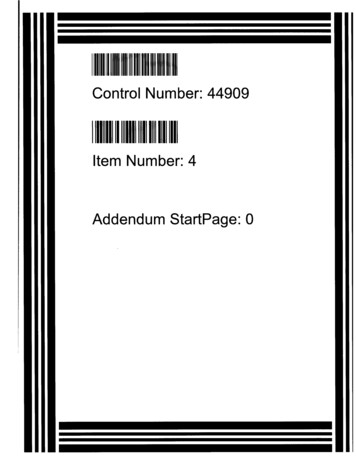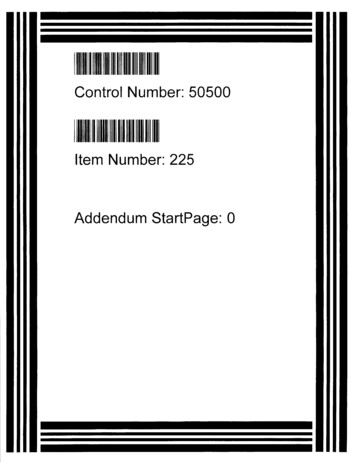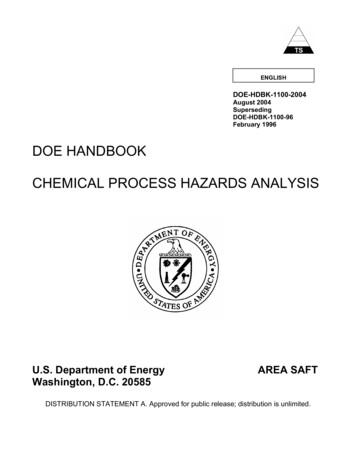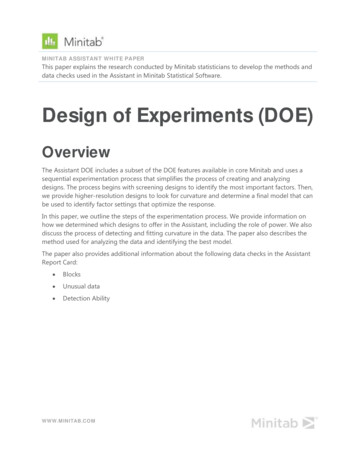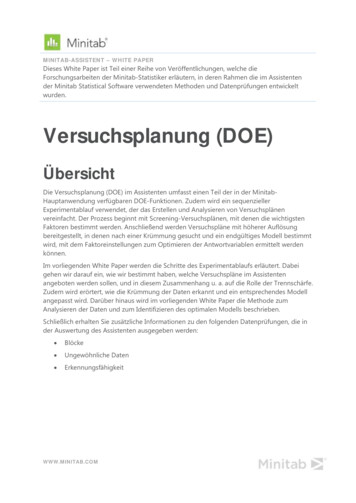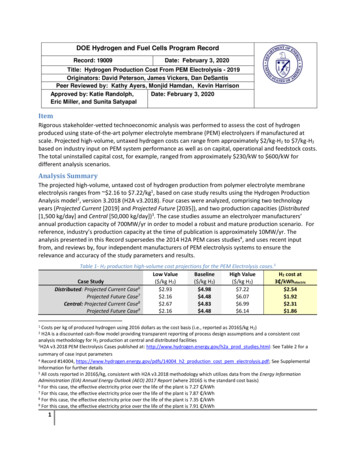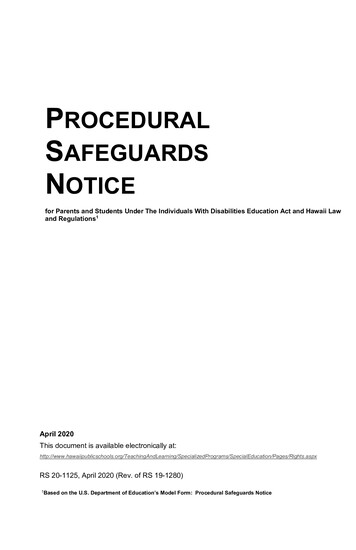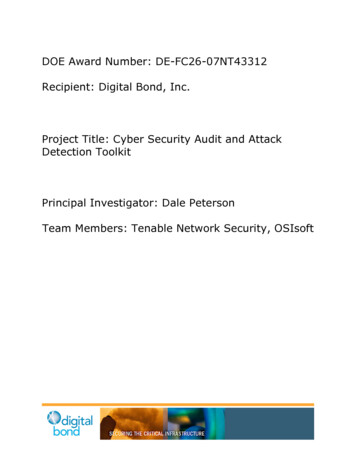
Transcription
DOE Award Number: DE-FC26-07NT43312Recipient: Digital Bond, Inc.Project Title: Cyber Security Audit and AttackDetection ToolkitPrincipal Investigator: Dale PetersonTeam Members: Tenable Network Security, OSIsoft
Final Technical Report for NT43312DISCLAIMERThis report was prepared as an account of work sponsored by an agency of the United States Government. Neitherthe United States Government nor any agency thereof, nor any of their employees, makes any warranty, express orimplied, or assumes any legal liability or responsibility for the accuracy, completeness, or usefulness of anyinformation, apparatus, product, or process disclosed, or represents that its use would not infringe privately ownedrights. Reference herein to any specific commercial product, process, or service by trade name, trademark,manufacturer, or otherwise does not necessarily constitute or imply its endorsement, recommendation, or favoringby the United States Government or any agency thereof. The views and opinions of authors expressed herein do notnecessarily state or reflect those of the United States Government or any agency thereof.Page 2 of 24
Final Technical Report for NT43312Final Technical Report for NT43312Cyber Security Audit and Attack Detection Toolkit1. Executive SummaryDigital Bond performed a research project for the Department of Energy that ran from 1 October2007 to 31 May 2012. This goal of this project was to develop cyber security audit and attackdetection tools for industrial control systems (ICS). This is the Final Technical Report for theproject. There are four sections in this report: Executive Summary Bandolier – Cyber Security Audit Tool Portaledge – Cyber Attack Detection Tool Contract Tasks and DeliverablesDigital Bond was able to complete all contract tasks and deliverables, and we were able toaccomplish this for 313,726 less than awarded for these tasks and deliverables.Cyber Security AuditDigital Bond developed and released a tool named Bandolier that audits ICS componentscommonly used in the energy sector against an optimal security configuration. You can think ofBandolier as a SCAP for ICS.We worked closely with the vendors that make the energy sector ICS, such as ABB, AlstomGrid, Emerson, OSIsoft, Siemens, Telvent and others, to determine the optimal securityconfiguration for components. This included both operating system security settings and ICSapplication security settings. A typical component would have about 200 security settings.Once the optimal security configuration was agreed on, Digital Bond then developed a .audit filethat worked with the industry leading Nessus Security Scanner. The result was a low impactaudit of the ICS components that identifies all variances with the optimal security configuration.All Bandolier Security Audit Files developed with Dept. of Energy funding are available free ofcharge.Bandolier has been highly successful measured by its impact and use in the industry. Forexample, Telvent’s Board of Directors made Bandolier one of their four strategic initiatives oneyear. Telvent uses Bandolier to verify new systems are deployed in the optimal securityconfiguration. Telvent is also an example the program will not end with the completion of Dept.of Energy. Telvent has updated the Bandolier file to audit new versions of their product,developed training videos, and even enhanced the Bandolier GUI.Alstom Grid is another example of a company that is using Bandolier during Factory and SiteAcceptance Testing to verify the system is in the optimal secure configuration. Digital Bond hasparticipated in acceptance tests with other vendor systems where Bandolier was used as well.Page 3 of 24
Final Technical Report for NT43312The result is new critical infrastructure control systems deployed in their optimal securityconfiguration.Owner/operators are downloading and using Bandolier to verify initial deployments, hardenexisting deployments and periodically audit securely deployed systems.Another indicator that the Bandolier program has been a success is vendors have engaged DigitalBond after the end of the Dept. of Energy project to develop Bandolier Security Audit Files.In addition to the Bandolier Security Audit Files for ICS components, the project also developedBandolier Baselines for Windows 7 and Windows 2008 Server and NERC CIP-007 scanpolicies. The Bandolier Baselines can be used by any vendor to audit their operating systemdeployment. The NERC CIP-007 scan policy collects information required for compliance.Cyber Attack DetectionThe Portaledge Project developed a capability for the PI Historian, the most widely usedHistorian in the energy sector, to aggregate security events and detect cyber attacks. The programmet all the technical objectives, but it was not adopted by the energy sector.The Portaledge Project releases would detect an attacker performing reconnaissance, affectingsystem availability, changes to the firewall configuration, and changes to open ports or listeningservices on workstations or servers. It could then display these alerts in the control center orforward the alerts to an enterprise security information and event management system.The primary reason the resulting capability was not adopted was it required the owner/operatorunderstand and modify some complex technology in the PI Server. Given the needed effort toachieve basic security controls, and how little progress was made on these basic controls, it isunrealistic to expect this complex and advanced technology be deployed.It may be of interest in the future, but even this is doubtful. In recent years, IT Security toolshave begun to penetrate the ICS networks. There are more full featured and off the shelf toolsthat could do the job of Portaledge and fit better with an enterprise strategy. Digital Bond doesnot recommend further work on Portaledge and will not be pursuing it ourselves.We would like to thank the Department of Energy for funding this research and their supportthroughout this project.Page 4 of 24
Final Technical Report for NT433122. Bandolier – Cyber Security Audit ToolThe Bandolier Security Audit Tool helps asset owners and vendors identify and audit optimalsecurity configuration for industrial control system (ICS) servers and workstations. Digital Bondpartners with leading ICS vendors to identify the optimal security configuration that still allowsthe vendor’s product to operate properly. This requires access to the vendor’s security experts,lead engineers and a test lab. Digital Bond then creates Bandolier Security Audit Files that workwith the compliance plugin in the Nessus vulnerability scanner.For asset owners and operators, the Bandolier Security Audit Files provide a way to verify thattheir systems are in an optimal, vendor-supported security configuration – both at the time ofdelivery to hold the vendors accountable and for ongoing, routine security auditing. In addition,the Bandolier reports provide valuable evidence for NERC CIP and other regulatory compliancerequirements. Vendors like Telvent, Alstom Grid, and OSIsoft are using Bandolier to helpdeliver hardened systems. They use Bandolier for acceptance testing and for routine securityvalidation testing in the patch and update process.The Bandolier program lives on after DoE funding has ended. Some vendors, such as AlstomGrid and Telvent, have updated the files as new versions of their products have come out. Othervendors have engaged Digital Bond to develop new Bandolier security audit files.Overview Defines optimal security configuration for SCADA and DCS servers and workstations Provides vendor-supported, customized security audit files for control systemapplications Provides a safe and effective way to audit the security of control system componentsHow it Works No client software, services, or agents are required on the control system server orworkstation User uploads Bandolier Security Audit Files to the Nessus vulnerability scanner Nessus policy compliance plugins make a low impact connection to the ICS server orworkstation Nessus uses built-in operating system functionality to compare the settings on the controlsystem server to those defined in the Bandolier Security Audit File Nessus provides a report that shows whether each setting matched what is in theBandolier Security Audit FilePage 5 of 24
Final Technical Report for NT43312Phase IThe main task in Phase I was to develop Bandolier Security Audit Files for at least 20 differentICS devices or components. A total of 23 different Bandolier Security Audit Files weredeveloped for ICS from leading energy sector systems such as ABB’s Ranger, Alstom Grid’seterra, Emerson Ovation, Matrikon’s Secure Tunneler, OSIsoft’s PI Server, SNC’s GENe,Siemens Telegyr and Telvent OASyS DNA. A complete list of the Bandolier Security AuditFiles created in Phase I is available in Section 4.The were two other Bandolier tasks in Phase I. First, to attempt to make the ICS securityapplication specific audit tests available in other scanners, Digital Bond converted all theBandolier Application Security Audit Files to the OVAL format. OVAL was selected becausethe testing envisioned by OVAL’s developers is similar to the Nessus audit capability. TheBandolier OVAL files were tested using MITRE's OVAL interpreter.Digital Bond discovered that most security tools, even those that explicitly support OVAL,require some level of conversion to the tool's native format. This combined with a lack of interestin the scanner vendors led Digital Bond to recommend this effort not be continued in Phase II.The second additional task was to develop a guide to help vendors develop something similar toBandolier. Digital Bond released the Security Configuration Audit Development Guide.There is a significant amount of additional documentation on digitalbond.com including: A Bandolier FAQ - er-faq/ A Bandolier Demonstration Video ier-demonstration-video/Page 6 of 24
Final Technical Report for NT43312 A Bandolier User Guide for Nessus ier-user-guide-for-nessus/ Bandolier and NERC CIP - er-andnerc-cip/The Bandolier Security Audit Files are available for free download loads/Phase IIWith the success of Bandolier in Phase I, Phase II included the decision to generate additionalBandolier Security Audit Files for ICS that are important in the energy sector. Bandolier SecurityAudit Files were developed for ABB 800xA, CSI UCOS, OSIsoft PI Server on Windows 2008Server and the SISCO AX-4 ICCP Server. The ABB 800xA and CSI UCOS actually consist ofmany different components, and a Bandolier Security Audit File was developed for eachcomponent.As part of this development, there were not existing quality audit files for Windows 7 andWindows 2008 Server R2. So Digital Bond developed these files that we call the BandolierBaselines. They are based on Microsoft security configuration recommendations and thenslightly modified for ICS concerns. For example, Microsoft recommends stopping operation iflogs are full. This would be unwise and unacceptable in an ICS. The Bandolier Baselines aredescribed at: ier-baselines/ and can bedownloaded on the Bandolier download page.The final Bandolier task in Phase II was to develop scan policies for NERC CIP-007. Policieswere developed that gather listening ports, running services, default account and othermiscellaneous information that is accessible by a security scanner and useful for CIP-007compliance. Information on the NERC CIP-007 scan policies is available -cip-scan-policies/.Page 7 of 24
Final Technical Report for NT433123. Portaledge – Cyber Attack DetectionThe initial thinking behind the Portaledge Project was as follows:1. ICS components generate a significant number of security events that would be useful inattack detection and after incident analysis.2. These ICS security events should be included in enterprise wide security event analysis.3. The Operations Organizations that run SCADA and DCS would not allow an ITDepartment to put an IT Security product, a Security Information and Event Management(SIEM), on the ICS network. Nor would the Operations Organizations allow the ITDepartment to deploy, manage and monitor a device on their ICS networks.4. ICS typically have one or more Historians. Full featured Historians aggregate events andcorrelate them to identify operational incidents and calculate key performance indicators.5. A full featured Historian could aggregate ICS security events and analyze these securityevents to detect cyber attacks.6. After collecting and analyzing ICS security events, the Historian could forwardappropriate security information to the Enterprise SIEM.While the technical objectives of the Portaledge Project were met, the future of this type ofadaption of an ICS Historian to an ICS SIEM is unlikely to have a significant market. Theprimary reason is traditional Enterprise SIEMs have made progress in penetrating the ICSnetworks amongst early adopters. The IT / Operations turf wars still remain, but they arereceding in early adopter organizations as the Operations Department realizes they need ITassistance and the IT Department becomes more educated on ICS culture and requirements.A secondary reason is resource related. Organizations have struggled to make progress securingICS since the project started in October of 2007. It will take a major investment in time andmoney to deploy and maintain basic security controls in critical infrastructure ICS over the next3 – 5 years. The effort to customize a Historian at each facility to work as an ICS SIEM is a lowpriority, particularly if the IT Department has an existing SIEM solution in the Enterprise thatcan be extended to the ICS network.The only way the Portaledge concept is likely to progress in the ICS space is if a major ICSvendor determined to add and support this capability to their Historian. The business case for thisseems highly unlikely.In summary, Portaledge was a technical success, in that all of the objectives and deliverableswere achieved, but a market failure. Digital Bond does not recommend future investment in theICS SIEM approach of Portaledge.Basic Technical ApproachPortaledge is a Digital Bond research project that aggregates security events from a variety ofdata sources on the control system network and then correlates the security events to identifycyber attacks. Portaledge leverages the aggregation and correlation capability of OSIsoft’s PIserver, and its large installed base in the energy sector to provide this cyber detection capabilityin a system many industrial control system (ICS) owner / operators already have deployed.Page 8 of 24
Final Technical Report for NT43312The security events are sent from the event source to a PI Interface and loaded as tags. The tagdata is then sent from the PI Interface to a PI Server. The ICS security data is now aggregated ata central site.Digital Bond then developed PI Advanced Computing Engine (ACE) modules to analyze thedata in the security event tags and detect events. A Portaledge release package consists of:Tag CreatorPI tags must be created for each security event sent to the PI server for aggregation andcorrelation.Alias CreatorThe Alias Creator provides the method to aggregate security event information in theform of asset owner tags into the normalized tags that Portaledge will use to correlatedata and detect attacks. This is the part of the project that will require the most work bythe asset owner, but creating tags is something PI users are very used to doing.The Alias Creator is provided as an Excel spreadsheet. The Alias Name is in one columnand the Asset Owner Tag Name is in an adjacent column. Each row will include adescription of the Asset Owner Tag that should be paired with the Alias Name. Forexample, an Alias Name could be CPU Utilization from the Windows performancemonitor or Firewall Syslog from the firewall.The completed spreadsheet is imported into the PI server and then the PI server has thedata that it will run event, event class event and meta event correlation rules on in theproper Alias Name format.ACE ModulesCorrelation takes place in the Advanced Computing Engine (ACE) modules. Each Eventhas at least one ACE module and may have multiple ACE modules if there are multipleEvent Triggers; each Event Class Event has an ACE module; and there is an ACEmodule for Meta Events. Each Event Class will have a zip archive that will include allEvent ACE modules in that Event Class and an Event Class Event ACE module.Event Modules are imported into the PI server using the PI ACE Scheduler.Datalink DisplaysOnce the Event, Event Class Events and Meta Events are identified by an ACE module,the name and chain are available in the PI Server. There are a tremendous amount ofways to present this information. Creating displays, sending pages, and other methods ofvisualization and notification are regular control system activities by PI users.One method of visualizing Portaledge Events, Event Class Events and Meta Events ispopulating a display page using OSIsoft’s Datalink display. Digital Bond may develop anumber of Datalink display pages and other methods of tracking the security status of acontrol system as part of Portaledge and other projects. This is an interesting area ofresearch. However, in the first release a simple Datalink display page will be includedthat will list the Events and Event Class Events in scrolling windows, and may includesome general security status indicators or trends.Page 9 of 24
Final Technical Report for NT43312Detailed installation information is available taledge-event-installation/Phase IIn Phase I Digital Bond developed modules to: Detect Availability Events Detect Enumeration Attacks Correlate Availability and Enumeration Attacks, called Meta Events in PortaledgeAvailability EventsThis section provides a summary of the Portaledge Availability Events. There are individualdocumentation pages for each Event that include significantly more detail and installationinstructions.Computer System Availability EventThe Computer System Availability Event will generate an alert when one of the triggers reachesa threshold. The thresholds can be modified by an administrator in theAliasCreator ComputerSystemAvailability.xls spreadsheet.Triggers CPU Utilization: This trigger will raise an alarm if the average CPU usage overthe past 5 minutes has reached the threshold (default is 85%). Memory Utilization: This trigger will raise an alarm if the average memory usageover the past 5 minutes has reached the threshold (default is 85%). Hard Disk Space: This trigger will raise an alarm if the percentage of free harddisk space has reached the threshold (default is 10%). Network Bandwidth: This trigger will raise an alarm if the average number ofpackets over the past 5 minutes has reached the threshold (default is 85%). Network Latency: This trigger will raise an alarm if the average network latencyover the past 5 minutes has reached the threshold (default is 30 ms).Interfaces Ping Interface: Used to determine network latency. TCP Response Interface: Used to determine network latency. Performance Monitor Interface: Used on Windows systems to determine CPUutilization, memory utilization, hard disk space, network bandwidth. SNMP Interface: Used on Linux systems to determine CPU utilization, memoryutilization, hard disk space, network bandwidth.Page 10 of 24
Final Technical Report for NT43312Network Device Availability EventThe Network Device Availability Event will generate an alert when one of the triggers reaches athresho
User uploads Bandolier Security Audit Files to the Nessus vulnerability scanner Nessus policy compliance plugins make a low impact connection to the ICS server or workstation Nessus uses built-in operating system functionality to compare the settings on the control system server to those defi
